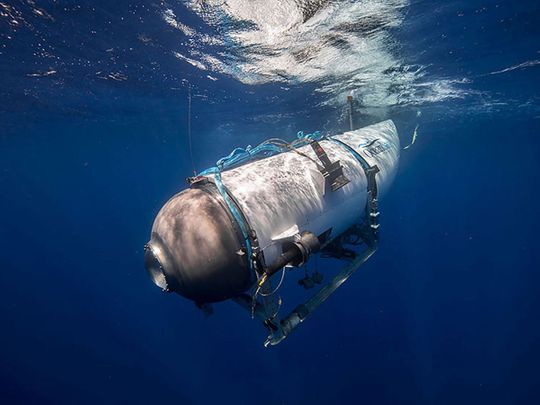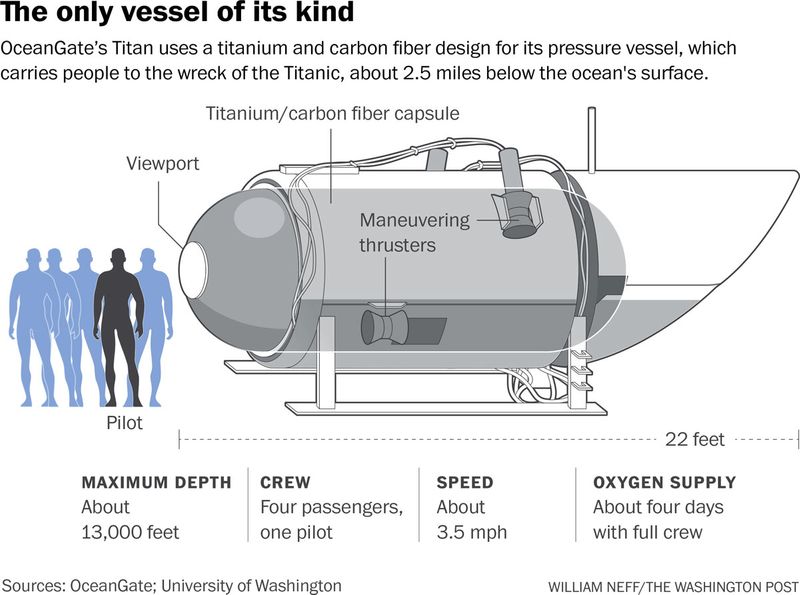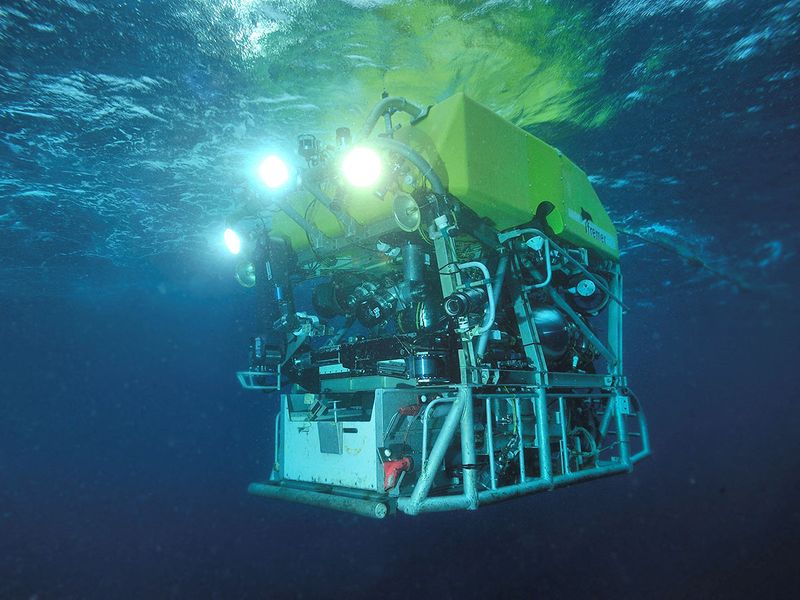
The five people aboard a missing submersible died in a "catastrophic" event, a Coast Guard official said on Thursday, bringing a grim end to the massive search for the vessel that was lost during a voyage to the Titanic. Rescue teams from several countries have spent days searching thousands of square miles of open seas with planes and ships for any sign of the 6.7-meter Titan, operated by US-based OceanGate Expeditions. The submersible lost contact on Sunday morning with its support ship about an hour and 45 minutes into what should have been a two-hour descent.
Follow the updates here:
The implosion was so fast that victims 'never knew it happened'
Death likely came very fast to the five passengers on board the Titan submersible and according to submarine experts, the vessel would have imploded and killed its crew so fast that those aboard "never knew it happened".
Ofer Ketter, an expert in submersibles, told The New York Post that said the "implosion would occur within a millisecond, if not a nanosecond, if something breached the hull of the vessel to cause a loss in pressure".
"They never knew it happened, which is actually very positive in this very negative situation. It was instantaneous - before even their brain could even send a type of message to their body that they're having pain," Ketter, co-founder of a private submersible company called Sub-Merge, was quoted as saying.
Debris from the OceanGate Expeditions' Titan submersible was found late on Thursday, confirming all those aboard had died.
What’s next?
The Coast Guard will continue searching near the Titanic for more clues about what happened to the Titan.
Officials say there isn’t a timeframe for when they will call off the massive international search. Rear Adm. John Mauger, of the First Coast Guard District, said that the prospect of finding or recovering remains was unknown.
White House offers condolences to families of victims
The White House offered its condolences to the families mourning the five people killed aboard the Titan submersible.
“Our hearts go out to the families and loved ones of those who lost their lives on the Titan,” the White House said in a statement. “They have been through a harrowing ordeal over the past few days, and we are keeping them in our thoughts and prayers.”
The statement also thanked the searchers, including the Coast Guard, involved in the international effort to find the submersible.
“This has been a testament to the skill and professionalism that the men and women who serve our nation continue to demonstrate every single day,” the statement said.
Family of British-Pakistani father and son expresses ‘profound grief’
The family of the British-Pakistani father and son who were among the five people who died on the Titanic tourist submersible expressed "profound grief" at their loss Friday.
Shahzada Dawood, 48, and his son Suleman, 19, are part of the Dawood industrial empire, which has become one of the most profitable in Pakistan.
"It is with profound grief that we announce the passing of Shahzada and Suleman Dawood," said a statement from the Dawood Foundation.
"We extend our heartfelt condolences to the families of the other passengers on the Titan submersible," it read, signed by Hussain and Kulsum Dawood, Shahzada's parents.
Titanic salvage rights owner mourns
RMS Titanic, Inc., the company that owns the salvage rights to the Titanic shipwreck, is mourning the loss of Titanic expert Paul-Henri Nargeolet, who was among five people killed aboard the Titan submersible when it imploded this week.
Nargeolet — known as “PH” — was a long-term employee of the company.
“The maritime world has lost an iconic and inspirational leader in deep-sea exploration, and we have lost a dear and treasured friend,” the company said in a statement Thursday.
Friend and former colleague Matthew Tulloch said Nargeolet loved his work from the time they collaborated in the 1990s up until Nargeolet’s death.
“I never got the impression that he was looking forward to retirement,” Tulloch said with a small laugh. “You sort of think of people as they retire, then they can go on and do things that they love to do. This was exactly that for him — I can’t think of anything that I’m aware of that he would enjoy doing more than traveling around and sharing information and his experiences with people.”
Pakistan offers condolences
Pakistan has offered the country’s condolences to the Dawood family after the father-and-son explorers were among five killed when the Titan submersible imploded deep in the North Atlantic waters during a trip to the Titanic's wreckage.
Pakistani nationals Shahzada Dawood and his son Suleman were aboard the Titan when it went missing Sunday. Authorities on Thursday said the catastrophic implosion meant there were no survivors.
“Our deepest condolences to the Dawood family and the family of other passengers on the sad news about the fate of Titanic submersible in the North Atlantic,” Pakistan’s Foreign Ministry wrote on Twitter. “We appreciate the multinational efforts over the last several days in search of the vessel.”
Sounds heard during search likely unrelated to titan sub
The Coast Guard says underwater sounds and banging noises detected in the search area for the Titan were likely unrelated to the missing submersible.
The sounds, heard over two days, gave hope to searchers and those watching the massive effort unfold since Sunday, when the vessel was reported missing, but ultimately seems irrelevant.
There doesn’t appear to be any connection between the noises and the location on the seafloor
Experts say the ocean floor is a “noisy” place and a potential connection between the banging and the Titan were unlikely.
UK sends 'deepest condolences' over lost sub
British foreign minister James Cleverly on Thursday said the government was supporting the families of those lost on board the Titan submersible, expressing his condolences in a post on Twitter.
"Tragic news that those on the Titan submersible, including three British citizens, have been lost following an international search operation," he said.
"The UK government is closely supporting the families affected and expresses our deepest condolences."
Search for bodies will continue: US Coast Guard
The Coast Guard will continue searching the sea floor near the Titanic shipwreck for more clues about what happened to the Titan submersible deep in the North Atlantic waters.
Officials say there isn’t a timeframe for when they will call off the massive international search. Efforts to recover the submersible and the remains of the five men who died in a catastrophic implosion aboard the vessel remain ongoing.
Much of the search is being done by remotely operated underwater vehicles known as ROVs that can scan the sea floor.
“This is an incredibly unforgiving environment down there on the seafloor,” Rear Adm. John Mauger of the First Coast Guard District said Thursday.
Titan sub likely imploded, leaving no survivors: Coast Guard
The Coast Guard says the Titan submersible likely imploded in the North Atlantic waters and there were no survivors among the five people aboard.
The implosion likely occurred near the Titanic shipwreck, where the submersible was headed.
“The debris is consistent with the catastrophic loss of the pressure chamber,” Rear Adm. John Mauger, the First Coast Guard District, said Thursday. “Our most heartfelt condolences go out to the loved ones of the crew.”

Five people on missing submersible believed to be dead
The company leading the Titan submersible trip to the wreckage of the Titanic says the five missing crew members are believed to be dead.
OceanGate Expeditions on Thursday says its pilot and chief executive Stockton Rush, along with passengers Shahzada Dawood and his son Suleman Dawood, Hamish Harding, and Paul-Henri Nargeolet “have sadly been lost.”
OceanGate did not provide details Thursday when the company announced the “loss of life” in a statement or how officials knew the crew members perished.
The vessel’s 96-hour oxygen supply likely ended early Thursday morning.
The company has been chronicling the Titanic’s decay and the underwater ecosystem around it via yearly voyages since 20
Owner of missing Titanic sub says crew has died: CNN
The owner of the submersible that went missing during a tourist expedition to the Titanic's wreckage says that the crew on board have "sadly been lost", CNN reported on Thursday.
"We grieve the loss of life," CNN reported OceanGate as saying.
"We now believe that our CEO Stockton Rush, Shahzada Dawood and his son Suleman Dawood, Hamish Harding, and Paul-Henri Nargeolet, have sadly been lost.
These men were true explorers who shared a distinct spirit of adventure, and a deep passion for exploring and protecting the world’s oceans. Our hearts are with these five souls and every member of their families during this tragic time. We grieve the loss of life and joy they brought to everyone they knew.
This is an extremely sad time for our dedicated employees who are exhausted and grieving deeply over this loss. The entire OceanGate family is deeply grateful for the countless men and women from multiple organisations of the international community who expedited wide-ranging resources and have worked so very hard on this mission.
We appreciate their commitment to finding these five explorers, and their days and nights of tireless work in support of our crew and their families.
This is a very sad time for the entire explorer community, and for each of the family members of those lost at sea.
We respectfully ask that the privacy of these families be respected during this most painful time."
Debris assessed to be from missing sub: CNN
Debris found on the ocean floor on Thursday near the wreck of the Titanic is thought to be from a missing tourist submersible, CNN reported citing an internal U.S. Coast Guard document, a grim development five days into an international search to save the five people aboard.
An unmanned deep-sea robot deployed from a Canadian ship discovered a "debris field" near where the century-old wreck is located, 2-1/2 miles (4 km) below the surface, the US Coast Guuard said earlier on Twitter. The agency has scheduled a press conference for 3 p.m. ET (1900 GMT) to discuss the findings.
The search for survivors is ongoing, according to the memo, CNN reported. It said the debris was from the external body of the vessel.
Parts of missing vessel found, reports claim
A report by Sky News, citing a rescue expert, claimed that the debris found included "landing frame” and a “rear cover” of the missing vessel. This has not been confirmed by official sources as of now.
Past rescues show challenges for the Titan
The search for the Titan submersible has drawn attention to other deep-sea rescues, only some of which ended in lives being saved. Those successful efforts — from a submersible off Ireland to a submarine off the New Hampshire coast — offer some measure of hope for the passengers and their families. But many ended with some, if not all, the passengers on board dying — demonstrating the inherent risk of operating in the deep ocean.
Either way, those rescue missions were not as complex as the effort to find the Titan submersible. They were often in shallower waters and, in several cases, were much bigger crafts.
For example, the USS Squalus sank off the coast of New England in 1939 during a test dive, due to a catastrophic valve failure that partially flooded the military submarine. A newly developed rescue chamber was lowered into the water to famously save the surviving 33 crew members. Twenty-six others drowned in the initial accident.
But the Titan is a civilian vessel and would not have standard Navy hatches that could attach to a rescue chamber like the one used for the Squalus. That makes it almost impossible to rescue any of the submersible’s occupants if they are found underwater.
Debris field found, US Coast Guard says
The US Coast Guard has said a debris field was discovered within the search area by a remotely operated vehicle near the Titanic. Experts within the unified command were evaluating the information, the Coast Guard said.
The coast guard said the debris field was found "within the search area by an ROV (Remotely Operated Vehicle) near the Titanic."
Titanic sub search vessel reaches sea floor
The search vessel reached the sea floor near the wreck of the Titanic and began looking for a missing submersible in an increasingly desperate effort to rescue the five-man crew before the dwindling air supply runs out.
The Canadian ship Horizon Atlantic deployed the remotely operated vessel, the US Coast Guard said on Thursday in a tweet. French vessel L'Atalante reached the search area and launched its own so-called ROV, the Coast Guard also said.
Time is crucial for the crew if they are still alive and their vessel remains intact. The Titan, which started with about 96 hours of air in case of an emergency, is theoretically down to its final reserves. The crew is also believed to have limited food and water.
Still, prospects for locating the missing vessel quickly remain dim, Rob Larter, a marine geophysicist for the British Antarctic Survey, said at a Science Media Centre briefing on Thursday.
'Needle in a haystack situation’
Scientists, while remaining realistic about the chances of finding the Titan on the vast ocean floor, are still offering a glimmer of hope.
Rob Larter, a marine geophysicist with the British Antarctic Survey, said in London on Thursday that it’s incredibly difficult to find an object the size of the Titan in a totally dark environment. He says it’s not going to be found with active sonar from a surface ship, but rather with a towed or autonomous vehicle that’s near the seafloor. Even those vehicles can see just a matter of meters.
“I’ve been involved in searches for hydrothermal vent sites,” he said. “We’ve the vehicles just a few tens of meters away and missed them and then come back and find them. So it really is, you know, literally it’s just a needle in a haystack situation unless you’ve got a pretty precise location”
Jamie Pringle, an expert in forensic geosciences at Keele University in the United Kingdom says the first 24 hours are critical in these kinds of rescue operations and that time period has long passed.
“So there’s always a chance. It’s never zero. But I think obviously the longer the time elapses, the lower the chance of success,” he said.
Larter called it a “desperate situation” buy says you try to stay optimistic as long as possible.
“It’s kind of unimaginable if people are alive, trapped in a submersible with oxygen supplies running down,” he said.
Still a search and rescue mission: US Coast Guard
The chief coordinator of a multinational mission to find a missing submersible near the Titanic wreck insisted Thursday he remains focused on rescuing the five-member crew alive, as concerns grew that their oxygen had run out.
"We continue to find in particularly complex cases that people's will to live really needs to be accounted for as well. And so we're continuing to search and proceed with rescue efforts," the US Coast Guard's Rear Admiral John Mauger told NBC's Today show.
Oxygen supply could be extended: Experts
The search is nearing the critical 96-hour mark when breathable air is expected to run out, reaching a vital moment in the intense effort to save the five people aboard.
The Titan submersible was estimated to have a 96-hour supply of breathable air when it launched Sunday morning in the North Atlantic. That means the deadline to find and rescue the sub is roughly between 6am (1000 GMT) and 8am (1200 GMT) on Thursday based on estimates the US Coast Guard and the company behind the expedition have provided.
Experts say that the oxygen supply number is an imprecise estimate and could be extended if passengers have taken measures to conserve breathable air. And it’s not known if they survived since the sub disappeared Sunday morning.
Britain has embedded submariner with search team
Britain has embedded a navy submariner with the team searching for a submersible that went missing near the wreckage of the Titanic, a spokesperson for Prime Minister Rishi Sunak said.
The spokesperson told reporters that an aircraft was also carrying specialist commercial equipment from the United Kingdom to assist with the search.
Search nears 96-hour mark for oxygen supply
The search for the missing submersible on an expedition to view the wreckage of the Titanic neared the critical 96-hour mark Thursday when breathable air is expected to run out, reaching a vital moment in the intense effort to save the five people aboard.
The Titan submersible was estimated to have a 96-hour supply of breathable air when it launched Sunday morning in the North Atlantic. That means the deadline to find and rescue the sub is roughly between 6am EDT (1000 GMT) and 8am EDT (1200 GMT), based on information the US Coast Guard and company behind the expedition have provided.
Experts emphasized that is an imprecise estimate and could be extended if passengers have taken measures to conserve breathable air. And it’s not known if they survived since the sub disappeared Sunday morning.
Frank Owen, a submarine search-and-rescue expert, said the oxygen supply figure is a useful “target” for searchers, but is only based on a “nominal amount of consumption.” Owen said the diver on board the Titan would likely be advising passengers to “do anything to reduce your metabolic levels so that you can actually extend this.”
Deep-sea diving robot nears search zone
A French research vessel carrying a deep-sea diving robot has slowed down as it reaches the search area for a missing submersible that was exploring the wreck of the Titanic, the Marine Traffic app showed.
Marine Traffic data showed the Atalante had slowed to a speed of 6 nautical knots and was located about 20 km to 30 km from the Polar Prince vessel which had carried the missing Titan submersible to waters above the Titanic wreck.
Deep-sea recovery equipment called in
Search teams looking for a submersible near the wreck of the Titanic called in specialist deep-sea recovery equipment as they clung to hopes the five-man crew is alive and can be saved during the final remaining hours of available air.
A fleet of search ships have amassed in the North Atlantic about 1,450 kilometers east of Cape Cod, Massachusetts, since the vessel went missing Sunday on a dive to survey the Titanic. The US Coast Guard said Wednesday the Navy is sending a lifting system to the area that can recover large and heavy sunken objects such as aircraft or small boats from deep water.
Rush, who is married to Wendy Rush, is chief executive of US-based OceanGate Expeditions which operates the Titan submersible that went missing on Sunday as it descended with him and four others to visit the Titanic wreck off Canada's coast.
Wendy Rush is a great-great-granddaughter of the retailing magnate Isidor Straus and his wife, Ida, two of the wealthiest people who were on the Titanic's maiden voyage when it sank after hitting an iceberg, the report said, citing archival records.
The tragic tale of Isidor Straus, co-owner of Macy's department store and his wife Ida, is recounted in James Cameron's blockbuster movie "Titanic".
Wendy Rush is a communications director with OceanGate and has previously undertaken three expeditions to the wreckage in 2021, 2022 and 2023, according to her LinkedIn page.
Time is crucial for the missing crew, if they are still alive and their vessel remains intact. The Titan, which started with about 96 hours of air in case of an emergency, is theoretically down to its final reserves. The crew is also believed to have limited food and water.
"We have to remain optimistic and hopeful," US Coast Guard Captain Jamie Frederick said at a briefing in Boston on Wednesday.
It's not clear whether there's enough time to retrieve the submersible "- even if it was found immediately "- before its air supplies deplete entirely. Frederick reiterated that the aim of the taskforce is still to safely rescue Titan's crew "- and the search will carry on for the time being.
Search intensifies
A multinational search team crisscrossed the sea and skies above the century-old wreck of the Titanic for a fifth day on Thursday, seeking a tourist submersible that went missing with five people aboard and was just hours away from the presumed end of its air supply.
The minivan-sized submersible Titan, operated by US-based OceanGate Expeditions, began its descent at 8 a.m. (1200 GMT) on Sunday. It lost contact with its surface support ship near the end of what should have been a two-hour dive to the site of the world's most famous shipwreck, in a remote corner of the North Atlantic.

The Titan set off with 96 hours of air, according to the company, meaning its oxygen tanks would likely be depleted some time on Thursday morning. How long the air would actually last, experts said, depended on various factors, such as whether the submersible still had power and how calm those aboard remained.
Still, the countdown to oxygen depletion posed only a hypothetical deadline, assuming the missing vessel was even still intact, rather than trapped or damaged in punishing depths at or near the sea floor.
read more
- OceanGate Titan missing: Titanic submersible has seven backup systems to return to the surface
- Missing Titanic submersible: Search for missing sub expands 'exponentially'
- Missing Titan submersible: UAE residents pray for safe return of Dubai-based British expat Hamish Harding, others onboard
- Filmmaker James Cameron made 33 submersible dives to the Titanic
Rescue teams, and loved ones of the Titan's five occupants, took hope in U.S. Coast Guard reports on Wednesday that Canadian search planes had recorded undersea noises using sonar buoys earlier that day and on Tuesday.
The Coast Guard said deployments of remote-controlled underwater search vehicles were redirected to the vicinity where the noises were detected, to no avail, and officials cautioned that the sounds may not have originated from the Titan.
"When you're in the middle of a search-and-rescue case, you always have hope," Coast Guard Captain Jamie Frederick said at a press conference on Wednesday. "With respect to the noises specifically, we don't know what they are." Frederick added that analysis of the sonar buoy data was "inconclusive." In one highly anticipated addition to the search, the French research ship Atalante was en route late on Wednesday to deploy a robotic diving craft capable of descending to a depth well below that of even the Titanic's ruins more than 2 miles down, the Coast Guard said.

The French submersible robot, dubbed the Victor 6,000, was dispatched at the request of the U.S. Navy, which was sending its own special salvage system designed to lift large, heavy undersea objects such as sunken aircraft or small vessels.
Speaking to the BBC on Wednesday, Ken Ledez, a hyperbaric medicine expert at the Memorial University in St John's, Newfoundland, said electrical power is likely to have a role in controlling the amount of oxygen and carbon dioxide inside the Titanic submersible, whose whereabouts remain unknown since June 18.
As the oxygen level falls, the proportion of carbon dioxide being breathed out by the crew will be rising, with potentially fatal consequences, Ledez noted.
"As levels of carbon dioxide build up, then it becomes sedative, it becomes like an anaesthetic gas, and you will go to sleep," he told the BBC, adding that too much of the gas in a person's bloodstream, known as hypercapnia, can kill them if not treated.
Meanwhile, former Royal Navy submarine captain Ryan Ramsey said he looked at videos online of the inside of Titan and could not see a carbon dioxide removal system, known as scrubbers.
"That for me is the greatest problem of all of them," the BBC quoted Ramsey as saying.
At the same time, the crew are at risk from hypothermia, where the body gets too cold.
According to Capt Ramsey, if the sub is on the seabed, the water temperature will be about zero degree. If it has also lost electricity, it will not be generating any power and therefore cannot generate heat.
Hypothermia, the lack of oxygen and the build-up of carbon dioxide within the sub mean the crew's ability to make contact with the search and rescue mission, such as by banging on the hull at regular intervals to try and attract attention, will dwindle.
"If they're unconscious, they're not going to be able to do much to help themselves," Ledez told the BBC.
- IANS
Drama in the deep
The drama was playing out in the icy waters beyond the east coast of Canada, where the British luxury liner RMS Titanic struck an iceberg and sank on its maiden voyage in 1912, killing more than 1,500 people.
The wreck of the cruise ship lies on the seabed at a depth of about 12,500 feet (3,810 meters), about 900 miles (1,450 km) east of Cape Cod, Massachusetts, and 400 miles south of St. John's, Newfoundland.
The Titan was carrying its pilot and four others on a deep-sea excursion to the shipwreck, capping a tourist adventure for which OceanGate charges $250,000 per person.
![The missing 5: [From top-left] British billionaire Hamish Harding; French explorer Paul-Henri Nargeolet; Founder and CEO of OceanGate Expeditions Stockton Rush; Pakistani-born businessman Shahzada Dawood and his 19-year-old son Suleman.](https://imagevars.gulfnews.com/2023/06/21/The-missing-5---From-top-left--British-billionaire-Hamish-Harding--French-explorer-Paul-Henri-Nargeolet--Founder-and-CEO-of-OceanGate-Expeditions-Stockton-Rush--Pakistani-born-businessman-Shahzada-Dawood-and-his-19-year-old-son-Suleman.-_188dbe86799_original-ratio.jpg)
The passengers included British billionaire and adventurer Hamish Harding, 58, and Pakistani-born business magnate Shahzada Dawood, 48, with his 19-year-old son Suleman, who are both British citizens.
French oceanographer and leading Titanic expert Paul-Henri Nargeolet, 77, and Stockton Rush, founder and chief executive of OceanGate, were also reported to be on board.
Sean Leet, who heads a company that jointly owns the support ship, the Polar Prince, told reporters on Wednesday that "all protocols were followed" but declined to give a detailed account of how communication ceased.
"There's still life support available on the submersible, and we'll continue to hold out hope until the very end," Leet, CEO of Miawpukek Horizon Maritime Services, told reporters.
Read more on the missing sub
- OceanGate Titan missing: Company was repeatedly warned of catastrophic safety problems of Titanic sub
- Pakistani billionaire and his son among five aboard missing Titanic submarine
- Read British expat in Dubai Hamish Harding's message just before Titanic site sub dive
- How did the submersible go missing near the Titanic wreck?
Even if the Titan were located, retrieving it would present huge logistical challenges.
If the submersible managed to return to the surface, spotting it would be difficult in the vast open sea, and it is bolted shut from the outside, preventing anyone inside from exiting without assistance.
If Titan is on the ocean floor, a rescue would be even more challenging because of the immense pressures and total darkness at that depth. Titanic expert Tim Maltin said it would be "almost impossible to effect a sub-to-sub rescue" on the seabed.
The French submersible on its way could be used to help free the Titan if it is stuck on the seabed, although the robot cannot lift the 21,000-pound (9,525-kg) craft on its own. The robot could also help hook the sub to a surface ship capable of lifting it, the operator said.
Questions about the Titan's safety were raised in 2018 during a symposium of submersible industry experts and in a lawsuit filed by OceanGate's former head of marine operations, which was settled later that year.












